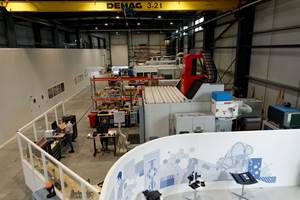Northwestern University researchers develop a hybrid polymer
The university believes this could lead to new concepts in self-repairing materials, drug delivery and artificial muscles.
A completely new hybrid polymer has been developed by Northwestern University (Evanston, IL) researchers.
"We have created a surprising new polymer with nano-sized compartments that can be removed and chemically regenerated multiple times," said materials scientist Samuel Stupp, the senior author of the study and director of Northwestern's Simpson Querrey Institute for BioNanotechnology. The study was published in the Jan. 29 issue of Science.
"Some of the nanoscale compartments contain rigid conventional polymers, but others contain the so- called supramolecular polymers, which can respond rapidly to stimuli, be delivered to the environment and then be easily regenerated again in the same locations. The supramolecular soft compartments could be animated to generate polymers with the functions we see in living things," he said.
The hybrid polymer combines two types of polymers: those formed with strong covalent bonds and those formed with weak non-covalent bonds known as "supramolecular polymers." The integrated polymer offers two distinct "compartments" with which chemists and materials scientists can work to provide useful features.
"Our discovery could transform the world of polymers and start a third chapter in their history: that of the 'hybrid polymer,'" Stupp said. "This would follow the first chapter of broadly useful covalent polymers, then the more recent emerging class of supramolecular polymers. We can create active or responsive materials not known previously by taking advantage of the compartments with weak non-covalent bonds, which should be highly dynamic like living things. Some forms of these polymers now under development in my laboratory behave like artificial muscles.”
Polymers get their power and features from their structure at the nanoscale. The university reports that the covalent rigid skeleton of Stupp's first hybrid polymer has a cross-section shaped like a ninja star -- a hard core with arms spiraling out. In between the arms is the softer "life force" material. This is the area that can be animated, refreshed and recharged.
"The fascinating chemistry of the hybrid polymers is that growing the two types of polymers simultaneously generates a structure that is completely different from the two grown alone," Stupp said. "I can envision this new material being a super-smart patch for drug delivery, where you load the patch with different medications, and then reload it in the exact same compartments when the medicine is gone."
Stupp and his research team also discovered that the covalent polymerization that forms the rigid compartment is "catalyzed" by the supramolecular polymerization, thus yielding much higher molecular weight polymers.
The strongly bonded covalent compartment provides the skeleton, and the weakly bonded supramolecular compartment can wear away or be used up, depending on its function, and then be regenerated by adding small molecules. After the simultaneous polymerizations of covalent and non- covalent bonds, the two compartments end up bonded to each other, yielding a very long, perfectly shaped cylindrical filament.
To better understand the hybrid's underlying chemistry, Stupp and his team worked with George C. Schatz, a world-renowned theoretician and a Charles E. and Emma H. Morrison Professor of Chemistry at Northwestern. Schatz's computer simulations showed the two types of compartments are integrated with hydrogen bonds, which are bonds that can be broken. Schatz is a co-author of the study.
"This is a remarkable achievement in making polymers in a totally new way—simultaneously controlling both their chemistry and how their molecules come together," said Andy Lovinger, a materials science program director at the National Science Foundation, which funded this research.
Related Content
JEC World 2024 highlights: Thermoplastic composites, CMC and novel processes
CW senior technical editor Ginger Gardiner discusses some of the developments and demonstrators shown at the industry’s largest composites exhibition and conference.
Read MorePlant tour: Daher Shap’in TechCenter and composites production plant, Saint-Aignan-de-Grandlieu, France
Co-located R&D and production advance OOA thermosets, thermoplastics, welding, recycling and digital technologies for faster processing and certification of lighter, more sustainable composites.
Read MoreCombining multifunctional thermoplastic composites, additive manufacturing for next-gen airframe structures
The DOMMINIO project combines AFP with 3D printed gyroid cores, embedded SHM sensors and smart materials for induction-driven disassembly of parts at end of life.
Read MorePlant tour: Collins Aerospace, Riverside, Calif., U.S. and Almere, Netherlands
Composite Tier 1’s long history, acquisition of stamped parts pioneer Dutch Thermoplastic Components, advances roadmap for growth in thermoplastic composite parts.
Read MoreRead Next
Ceramic matrix composites: Faster, cheaper, higher temperature
New players proliferate, increasing CMC materials and manufacturing capacity, novel processes and automation to meet demand for higher part volumes and performance.
Read MoreScaling up, optimizing the flax fiber composite camper
Greenlander’s Sherpa RV cab, which is largely constructed from flax fiber/bio-epoxy sandwich panels, nears commercial production readiness and next-generation scale-up.
Read MoreUltrasonic welding for in-space manufacturing of CFRTP
Agile Ultrasonics and NASA trial robotic-compatible carbon fiber-reinforced thermoplastic ultrasonic welding technology for space structures.
Read More












